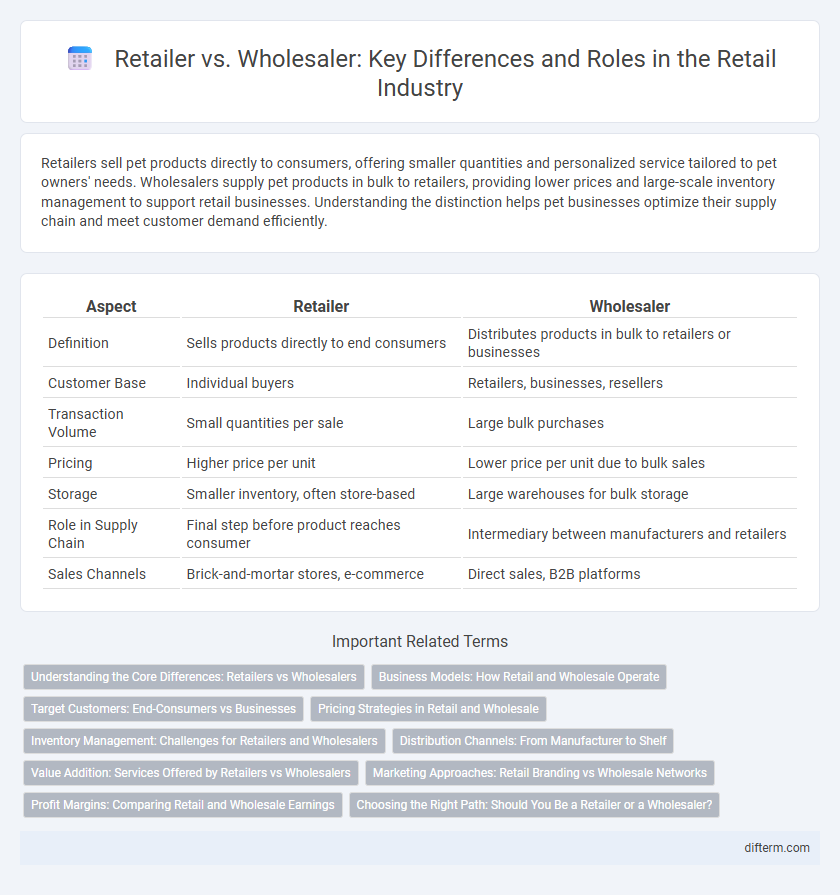Retailers sell pet products directly to consumers, offering smaller quantities and personalized service tailored to pet owners' needs. Wholesalers supply pet products in bulk to retailers, providing lower prices and large-scale inventory management to support retail businesses. Understanding the distinction helps pet businesses optimize their supply chain and meet customer demand efficiently.
Table of Comparison
| Aspect | Retailer | Wholesaler |
|---|---|---|
| Definition | Sells products directly to end consumers | Distributes products in bulk to retailers or businesses |
| Customer Base | Individual buyers | Retailers, businesses, resellers |
| Transaction Volume | Small quantities per sale | Large bulk purchases |
| Pricing | Higher price per unit | Lower price per unit due to bulk sales |
| Storage | Smaller inventory, often store-based | Large warehouses for bulk storage |
| Role in Supply Chain | Final step before product reaches consumer | Intermediary between manufacturers and retailers |
| Sales Channels | Brick-and-mortar stores, e-commerce | Direct sales, B2B platforms |
Understanding the Core Differences: Retailers vs Wholesalers
Retailers sell products directly to end consumers, emphasizing customer experience and convenience through physical stores or e-commerce platforms. Wholesalers act as intermediaries, purchasing large quantities from manufacturers to supply products in bulk to retailers or other businesses, focusing on volume and distribution efficiency. Understanding these roles helps clarify the supply chain dynamics and pricing strategies within the retail ecosystem.
Business Models: How Retail and Wholesale Operate
Retailers purchase goods from wholesalers or manufacturers and sell them directly to consumers, tailoring their business models to individual customer preferences and small-quantity sales. Wholesalers operate by buying large volumes of products from producers and distributing them in bulk to retailers or other businesses, focusing on high-volume transactions and logistical efficiency. The core difference lies in the customer base and transaction scale, with retailers emphasizing customer experience and wholesalers prioritizing supply chain management.
Target Customers: End-Consumers vs Businesses
Retailers primarily target end-consumers by offering products in smaller quantities for personal or household use, while wholesalers focus on supplying large volumes to businesses such as retailers, manufacturers, or institutions. Retail transactions typically involve detailed customer service and marketing tailored to individual buyer preferences. Wholesalers emphasize bulk pricing and efficient distribution to support business operations and inventory management.
Pricing Strategies in Retail and Wholesale
Retailers often use dynamic pricing strategies tailored to consumer demand, seasonality, and competitor pricing to maximize profit margins while maintaining customer loyalty. Wholesalers typically apply volume-based pricing and bulk discounts to incentivize large orders from retailers, focusing on economies of scale and minimizing transaction costs. Effective pricing in retail and wholesale depends on understanding target market behaviors, cost structures, and price elasticity to optimize sales and profitability.
Inventory Management: Challenges for Retailers and Wholesalers
Retailers face challenges in inventory management such as demand variability, limited storage space, and the need for frequent restocking to meet consumer preferences. Wholesalers manage larger volumes with complexities in bulk inventory tracking, longer lead times, and coordination with multiple suppliers and retailers. Both require advanced inventory management systems to optimize stock levels, reduce carrying costs, and ensure timely product availability.
Distribution Channels: From Manufacturer to Shelf
Retailers purchase products in smaller quantities directly from wholesalers or manufacturers to sell them to end consumers, ensuring product accessibility in local markets. Wholesalers operate as intermediaries, buying large volumes from manufacturers and distributing them to multiple retailers, optimizing supply chain efficiency. Distribution channels streamline the flow of goods from manufacturers to retail shelves, facilitating inventory management and meeting consumer demand effectively.
Value Addition: Services Offered by Retailers vs Wholesalers
Retailers add value by offering personalized shopping experiences, including product demonstrations, customer support, and flexible return policies, enhancing convenience and satisfaction for end consumers. Wholesalers focus on bulk distribution, providing cost savings and efficient supply chain management to retailers and businesses rather than direct consumer services. This differentiation highlights retailers' role in customer engagement and service, contrasted with wholesalers' emphasis on logistics and volume-based pricing.
Marketing Approaches: Retail Branding vs Wholesale Networks
Retailers emphasize building strong brand identities through targeted advertising, customer loyalty programs, and personalized in-store experiences to drive direct consumer engagement and trust. Wholesalers focus on establishing expansive distribution networks, bulk pricing strategies, and B2B relationship management to efficiently supply products to multiple retail outlets. These distinct marketing approaches reflect retailers' consumer-centric branding versus wholesalers' network-driven sales optimization.
Profit Margins: Comparing Retail and Wholesale Earnings
Retailers typically experience higher profit margins per unit sold due to direct consumer pricing, often ranging between 20% to 50%. Wholesalers operate with lower margins, usually between 5% to 15%, but compensate through high-volume sales and bulk transactions. The disparity in profit margins reflects differences in operational costs, inventory turnover, and market positioning within the supply chain.
Choosing the Right Path: Should You Be a Retailer or a Wholesaler?
Choosing between being a retailer or a wholesaler depends on your target market, inventory capacity, and profit margin goals. Retailers sell products directly to consumers, focusing on diverse product ranges and customer experience, while wholesalers supply large quantities to businesses, emphasizing bulk sales and lower prices. Understanding your operational strengths and market demand will guide the decision to optimize revenue and growth in the retail industry.
Retailer vs Wholesaler Infographic

 difterm.com
difterm.com